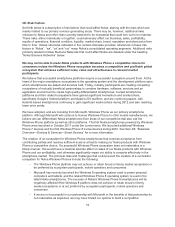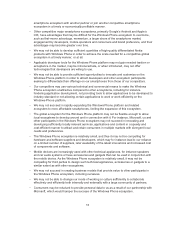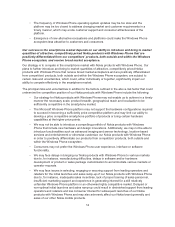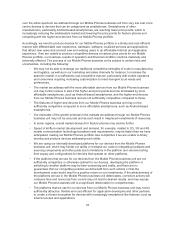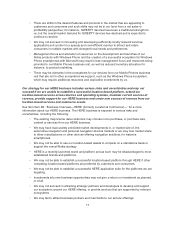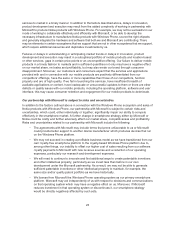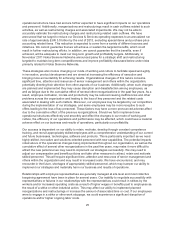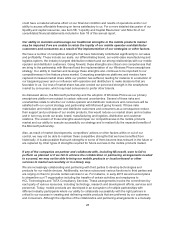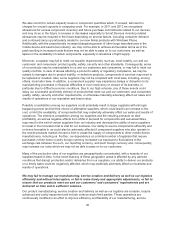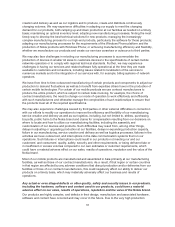Nokia 2012 Annual Report Download - page 22
Download and view the complete annual report
Please find page 22 of the 2012 Nokia annual report below. You can navigate through the pages in the report by either clicking on the pages listed below, or by using the keyword search tool below to find specific information within the annual report.for feature phones and more affordable smartphones. Some of our competitors may also benefit from
governmental support in their home countries and other measures that may have protectionist
objectives. These factors could reduce the price competitiveness of our feature phones and have an
adverse effect on our sales and profitability.
The growing significance of ecosystems has further reinforced the importance of product design as a
means for differentiating offerings from others within the same or a different ecosystem. Additionally,
together with the growth of cloud computing, where data and services are hosted by remote servers
rather than on devices themselves, ecosystems are also leading some vendors to pursue a strategy of
developing and providing devices and electronic products of different form factors and screen sizes,
such as mobile devices, tablets and televisions and software which make them compatible and support
their smooth interaction with one another. As consumers acquire different devices, some may choose
to purchase products and services from only one ecosystem or vendor. If our competitors succeed in
capturing markets where we are not currently present, this could erode our competitive position. For
instance, we currently do not have tablets or other adjacent products in our mobile product portfolio,
which may result in our inability to compete effectively in the tablet and developing multi-screen market
segments in the future or forgoing those potential growth opportunities, and may also have an adverse
effect on the desirability of our smartphones.
Consumers may be more reluctant to provide personal data to us, which would hamper our competitive
position in terms of our current business models, or new business models, that rely on access to
personal data. For instance, the possible inability to collect and utilize consumer behavioral data may
prevent us from efficiently developing product and services, do efficient marketing, take actions to
enable consumer retention and work efficiently with service developers.
A key component of our current strategy is investment in future disruptive technologies, including
investment in longer-term market exploration of next-generation devices, platforms and user
experiences. Additionally, we continuously seek new business and monetization models. Certain of our
competitors have significant resources to invest in market exploration and seek new monetization
models or drive industry development and capture value in areas where we are not competitive. Those
areas can be, for instance, monetization models linked to the use of large amounts of consumer data,
large connected communities, home entertainment services and alternative payment mechanisms. We
may not be able to invest our own resources to compete in these areas, which may in the future prove
a competitive disadvantage for us. If we fail in these aspects of our strategy, we may not realize a
return on our investments or may incur operating losses and impair our competitiveness for the longer
term.
With respect to digital map data and related location-based content, several global and local
companies, as well as governmental and quasi-governmental agencies, are making more map data
with improving coverage and content, and high quality, available free of charge or at lower prices. For
example, our HERE business competes with Google which uses an advertising-based model allowing
consumers and companies to use its map data and related services in their products free of charge to
consumers. Google has continued to leverage Google Maps as a differentiator for Android bringing
certain new features and functionality to that platform. Apple has also sought to strengthen its location
assets and capabilities through targeted acquisitions and organic growth.
HERE also competes with companies such as TomTom, which licenses its map data and where
competition is focused on the quality of the map data and pricing, and Open Street Map, which is a
community-generated open source map available to users free of charge. Aerial, satellite and other
location-based imagery is also becoming increasingly available and competitors are offering location-
based products and services with the map data to both business customers and consumers in order to
differentiate their offerings. Those developments may encourage new market entrants, cause business
21



